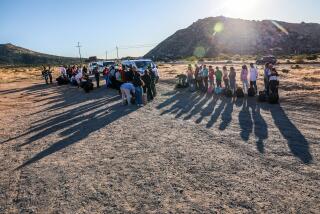Inside Look at Human Smuggling
HAVANA — Convicted smuggler Joel Dorta Garcia sat inside the forbidding compound of Cuba’s Department of State Security and showed little remorse while describing the journey that killed a man.
Dorta was trying to outrun the Cuban Border Guard and reach U.S. waters in 1999 in an overloaded 32-foot Scorpion speedboat when the cap blew off a 200-gallon gas tank on deck.
The 14 paying passengers screamed as gasoline soaked their legs. The seas were rough. There was no moon. And the Border Guard officers speeding alongside the boat were shouting for Dorta to stop, to save the men, women and children on board from almost certain disaster and to turn himself in.
“I said, ‘I’m not stopping,’ ” the Cuban American said coolly in an interview room here last month, reliving that night. “I didn’t force these people to get on the boat. And I thought, ‘If I stop, we’ll capsize and I’ll never get home.’ ”
Now, Dorta most likely never will. The Scorpion did flip over, killing 47-year-old Sergio Maurilio Martinez. The Border Guard captured the 29-year-old smuggler and saved the rest of his human cargo, who, according to prosecutors and survivors, had paid $8,000 each for the crossing.
Dorta is among nearly a dozen Cuban Americans who have been convicted under Cuba’s tough new anti-smuggling laws and one of two sentenced to life in prison in this nation’s effort to deter the multimillion-dollar trade in illegal migrants.
But the smuggling continues to grow exponentially, driven by the yearning of about 1 million divided families, the Border Guard’s limited resources and, critics say, a U.S. policy that permits any Cuban who illegally reaches American soil to remain. Virtually nonexistent before the implementation of that policy in 1996, the smuggling of Cubans for profit has roughly doubled in each of the past four years, Cuban statistics show, while scores of people have died in failed attempts to illegally cross the treacherous seas between here and the U.S. shoreline.
Those are among the findings of a rare look inside the Cuban government’s secretive Border Guard, its judicial system and its prisons--all long off limits to outside observers.
For a week, Cuban authorities permitted a reporter to tour their aging naval fleet, accompany a Border Guard patrol in a speedboat confiscated from Florida smugglers and interview several of the more than 70 Cuban Americans who have been jailed here for illegally transporting humans.
For the government of President Fidel Castro, the unique access was meant to show Cuba’s commitment to policing a trade that U.S. authorities privately concede they are powerless to deter.
A Castro Campaign During Elian Episode
Castro’s campaign against the U.S. immigration policy reached new heights during the prolonged legal battle over custody of young Cuban castaway Elian Gonzalez, who survived a smuggler’s journey that killed his mother and 10 others in November 1999. The Cuban leader insists that the policy is a magnet that draws economic migrants to their deaths with little or no official deterrence from the U.S.
Cuban court records show that smugglers caught and prosecuted here routinely have been sentenced to 20 or 30 years in prison since tougher laws took effect in April 1999.
By contrast, thousands of pages of U.S. federal court records on file in South Florida show that smugglers convicted for similar offenses in Miami--even for those in which deaths occurred--received far lighter sentences from U.S. judges.
“The problem is that the U.S. side isn’t doing its part to stop this terrible business,” said Maj. Ernesto Hernandez Gomez, a Border Guard commander. “The American government doesn’t punish them. If they were doing what we’re doing, the number of these journeys would diminish very quickly.”
Hernandez and half a dozen other Border Guard commanders interviewed along the island’s northern coast, where they patrol a 12-mile territorial limit, echoed the frustration of many U.S. Border Patrol and Coast Guard officers, who are responsible for stopping the smugglers after they leave Cuban waters but before they reach the Florida coast.
Under the U.S. policy informally known as “wet foot/dry foot,” Cubans intercepted by U.S. authorities at sea are sent home--an American commitment enshrined in bilateral immigration treaties signed in the mid-1990s. The Cubans in turn have agreed not to jail or prosecute those sent home.
But, in what Cuban officials have repeatedly asserted is a breach of those accords, their nationals who reach Florida’s shore illegally are “paroled” into the U.S. and automatically get residency status in a year, although the smugglers who bring them are subject to federal prosecution.
Privately, several U.S. federal prosecutors say the seemingly contradictory policy makes smuggling cases difficult to try in South Florida, where many judges and juries view Cuban migrants as political refugees.
The net effect, Cuban and U.S. authorities agree, is that the numbers are on the rise.
Cuban Official Blames ‘Fast . . . Easy Money’
The Border Guard said that last year it recorded more than 150 human-smuggling missions launched from Florida, each picking up at least a dozen passengers from Cuba’s northern coast. More than a third of those efforts were successful, according to the Border Guard. The agency, an Interior Ministry force with a mission similar to the U.S. Coast Guard, recorded fewer than 100 such journeys in 1999 and just 50 in 1998.
Coast Guard statistics show that, in the past year, as many as 1,000 Cubans were intercepted approaching the U.S. and sent back. But U.S. Border Patrol records indicate that at least double that number made land, and a spokesman said the Border Patrol arrested only a handful of smugglers in Florida waters last year.
Cuban Border Guard officials conceded that their own lack of resources, combined with the enormous profit potential in the smuggling trade, has added to the industry’s growth.
“It’s fast money, and it’s easy money,” said Lt. Col. Ramon Ramirez, the Border Guard’s chief protocol officer.
Added senior State Security prosecutor Lt. Col. Orlando Soroa Clapera: “If we had the capacity to intercept every smuggling boat that came into our territory, there would be hundreds of U.S. citizens detained in our jails. Conservatively, I’d estimate we have been able to catch not even 5% of them.”
Although small radar stations ring this nation’s coastline, they use aging Russian and British equipment to monitor the shore and more than 4,000 islands and keys. There also are huge gaps in the radar net that Border Guard officials conceded are known to smugglers who were born and raised in Cuba.
But those officials added that they concentrate most of their radar assets on the coastal tourist resorts and industrial towns that are vital to the economy, rather than the more desolate coastline frequented by smugglers.
To beef up its patrols, the Border Guard recently intensified efforts to seize smugglers’ speedboats, which are much faster than the agency’s decades-old 74-foot vessels. The Cuban authorities have dozens of these speedboats and use them to catch more smugglers, though officials quickly added that the boats have only a limited value.
“The problem for us is that, even if we had 100 speedboats or 200, it won’t help us much,” said Ramirez, the protocol officer. “They guzzle very expensive gasoline--98 octane. We can’t afford to use these boats anywhere near as much as we’d like.
“That’s why our real effort is aimed at stopping the people on land, to frustrate their departure before they leave. Sometimes it’s as simple as a boy telling his teacher he won’t be in school tomorrow. We follow up on everything. Because once they’re on board, the people think they’re already in the United States. They become more aggressive, more defiant.”
What is more, he stressed, the Border Guard has been under strict orders not to use force to stop smugglers at sea ever since a boat sank during a forcible interdiction in 1993 and a dozen people died. Instead, the Border Guard pursues speeding smugglers, appealing to them through megaphones to stop, until their boats either break down or reach U.S. waters.
In each case of a successful flight, Cuban authorities fax the U.S. Coast Guard in Miami details of the smuggler’s boat registration, position and heading--a rare point of direct contact between the two nations’ forces. But Ramirez complained that the faxes are rarely answered.
Replied Coast Guard spokesman Lt. Cmdr. Ron LaBrec in Miami: “We do get faxes in from the Cuban Border Guard pretty routinely. If we’re able to act on it with vessels or aircraft in the area, we act on it. . . . Sometimes we do, sometimes we don’t.”
Just who ultimately is behind the trade and who profits most from it remain a mystery to the two governments. Investigators on both sides of the Straits of Florida say the speedboat pilots are mostly pawns in a game in which the major players, organizers and financiers are never caught.
Joel Dorta Garcia and other smugglers imprisoned here appear to be living proof.
Dorta fled Cuba in a 19-foot wooden raft in 1994 and spent nearly five years fishing lobster and living well on Florida’s Key West. He insisted in the interview that he ended up at the helm of the Scorpion only for the sake of his wife and children.
He denied assertions by Cuban prosecutors and witnesses that Miami-based organizers had paid him $45,000 for the July 3, 1999, journey, claiming instead that he did it to repay the boat owner for a successful run Dorta had made to Cuba the previous month to get his family out.
Dorta also said he was never given a chance to explain that during his one-day trial here, where he said he met his defense attorney only minutes before the opening gavel and was given only a few minutes to speak in his defense.
But the young smuggler, who said he didn’t know of Cuba’s harsh penalties before he was caught, insisted that he had no regrets; he is content knowing that his family is safe in Key West, where his wife works in a coffee shop.
When asked, though, whether repealing the wet foot/dry foot policy would eliminate much of the smuggling trade, as Cuba asserts, Dorta shook his head. As long as Cubans want to leave, he said, the business will thrive.
So what will it take to stop it?
“My answer,” a hesitant Dorta replied with a wry smile, “may have a great cost to me. Maybe I’ll get another life sentence.”
More to Read
Sign up for Essential California
The most important California stories and recommendations in your inbox every morning.
You may occasionally receive promotional content from the Los Angeles Times.










